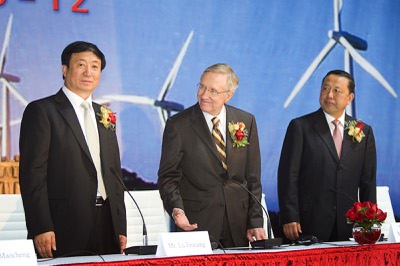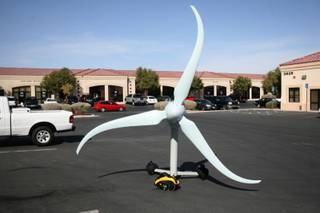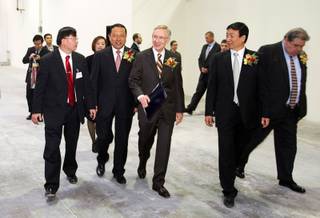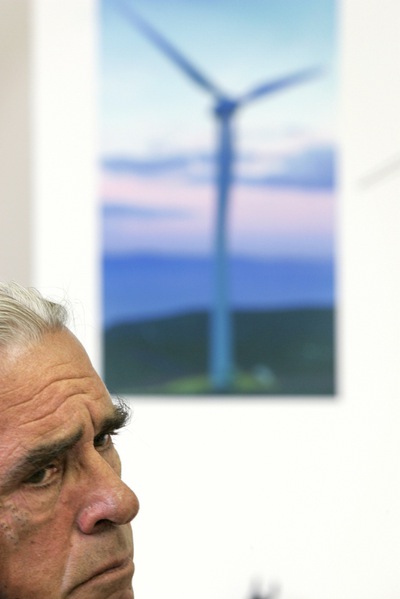Friday, March 30, 2012 | 2 a.m.
Other Sun stories of interest
- Apparently, you can spend too much in Vegas — doing so cost GSA official her job (3-3-2012)
- Los Angeles man grateful to Luxor employee who turned in his backpack — and Rolex (3-3-2012)
- Palms rolls out unwelcome mat for longtime hotel frequenter Vince Neil (3-3-2012)
- Seven Las Vegas Valley condos and what it costs to live there (3-3-2012)
- Glowing orbs caught in Luxor beam remain a mystery (3-2-2012)
Sun coverage
- Regulators to NV Energy: Stop subsidizing low-energy light bulbs (03-15-2012)
- Public Utilities Commission calls for better data on smart meters (02-21-2012)
- To lower utility bills, NV Energy efficiency programs might get axe (02-16-2012)
- Why Nevada is missing the boat on renewable energy industry (02-26-2012)
- Regulators question NV Energy plan to export renewable power to California (01-27-2012)
- More stories on energy
A year ago, a Reno clean energy businessman warned the Public Utilities Commission that if it didn’t set a few standards for NV Energy’s wind rebate program, its customers could end up footing the bill for turbines that rarely produce electricity.
One reason behind his concern: To be eligible for rebates, customers didn’t need to prove that the wind actually blows enough to justify installing a turbine on their property.
“This could allow unscrupulous developers to sell turbines to unsuspecting customers who will not generate electricity from an installed turbine because there is no wind to power the turbine,” Clean Energy Center managing member Rich Hamilton told the PUC last May. “This problem is especially vexing because ratepayer money could be contributing to the cost of such turbines, which could give the Wind Generations program and the wind industry a black eye.”
The PUC agreed that such a standard would be a good idea but sided with NV Energy’s position that it was too early to move forward with it just yet.
A year later, however, Hamilton’s warning appears to have been spot on.
The electricity produced by NV Energy’s $46 million wind rebate program has fallen far short of expectations.
In a startling example, the city of Reno’s wind turbines — for which the city received more than $150,000 in rate-payer funded rebates — produced dramatically less electricity than the manufacturers of its turbines promised.
“These manufacturers, when they gave us the turbines, they said they were designed to be mounted on a parapet at this height, and that’s what we did,” said Jason Geddes, who runs the city of Reno’s renewable energy program. “But when we started getting actual wind flow patterns, we realized their claims were wrong.”

Jinxiang Lu, left, Chairman/CEO of A-Power, Senate Majority leader Harry Reid, center, and Kai Huang, deputy mayor of Shenyang, China, stand during the dedication of a new A-Power Energy Generation Systems manufacturing facility in Henderson Tuesday, October 12, 2010. The company, based in China, will produce wind turbines and LED lighting.
As first reported by the Reno Gazette-Journal, one turbine that cost the city $21,000 to install saved the city $4 on its energy bill. Overall, $416,000 worth of turbines have netted the city $2,800 in energy savings.
Not all of the city’s turbines performed so poorly. But on average, the small wind turbines installed statewide through NV Energy’s program have yielded disappointing results.
“There is a lot of difference in some of the generators relative to what the (manufacturers) claim,” said John Hargrove, who manages NV Energy’s Renewable Generations program. “A generator can claim to put out 100 kilowatt hours, but that’s based on an assumption that there’s a certain amount of wind. If you don’t have the wind, you won’t have the output.”
That’s exactly why Hamilton pleaded with the PUC to impose a requirement that customers first prove their wind resource before winning a rebate.
“I’m terribly worried about the future of the program,” said Hamilton, whose company does solar and wind projects. “We really, really feel strongly about this. I’m a rate-payer. And if the rate-payers are paying for this, the rate-payer should be getting the most bang for their buck.”
Hamilton also believes equipment standards should be in place to minimize faulty turbines, some of which have fallen apart.
That’s happened both in Reno and in rural Nevada. Geddes said one of his turbines that was rated to 110 mph fell apart in a 105-mph gust.
A more catastrophic failure occurred on a farm in rural Nevada, when a large turbine spun apart only days after it was installed. No one was injured, largely because it was in a remote locale.
“It was very spectacular,” said Matt Newberry, who runs NV Energy’s wind program. “It was only up for a matter of days. We’re relieved we haven’t had any more of those.”
Unlike the solar industry, which has figured out how to correctly install productive solar generators on rooftops and in parking lots across the state, the wind industry in Nevada is still in its infancy.
So far, statewide, about 150 turbines have been installed through a rebate program created by the 2007 Legislature.
Under the demonstration programs, cities, schools, businesses and homeowners are eligible for a rebate up to the full cost of the turbine depending on a variety of factors including the system’s wattage.
The vast majority of the projects are in Northern and rural Nevada. Most of the cost of the program is born by rate-payers of Sierra Pacific, as NV Energy’s Northern Nevada sister company is known, and not the utility’s Southern Nevada customers.
The PUC is again considering the requirements advocated by Hamilton — requirements that will govern the program statewide.
Power company officials first worried stringent requirements could strangle the budding industry. But after a year of experimenting with the program, they appear on board with both resource and equipment standards.
“I think it’s a really smart evolution of the program,” Newberry said. “When it was instituted, nobody really knew much about wind in the state. The market itself, even the Legislature, labeled it as a demonstration program.
“But we want to make sure customers are getting good things. We don’t want to see people install them in places where there’s not good wind.”
Hargrove declared the demonstration successful, largely because of how much the company has learned about small wind projects. He noted the wind program doesn’t make much sense in Nevada’s urban centers.
“Rather than putting a little one in the backyard of a home, we’re focusing on much larger projects that go out on a farm,” he said. “While some early projects are not producing great results, it’s not because wind doesn’t work. We’re tightening up our standards.”
In its newest filing before the PUC, the company is advocating a 10-mph average wind speed standard to be eligible for the rebate.
Not so fast, Geddes warned.
He noted that models used to calculate average wind speed aren’t reliable. For example, the city’s two most productive wind turbines wouldn’t have been eligible for the rebate because wind studies said the average wind speed was below 10 mph.
The only accurate way to test average wind speed is to install an anemometer and take readings for a year, Geddes said.
Geddes would rather see a performance-based incentive. To get a rate-payer-funded rebate, a customer would have to prove the turbine produced electricity.
Such an incentive was passed by the Legislature last year. But Gov. Brian Sandoval vetoed the bill after NV Energy won a last-minute amendment to fund a major transmission line project.
Hamilton countered that investing in an anemometer might not be such a bad idea.
“If you are going to invest tens of thousands in something, it may be worth waiting to do a wind resource assessment,” he said.




Join the Discussion:
Check this out for a full explanation of our conversion to the LiveFyre commenting system and instructions on how to sign up for an account.
Full comments policy